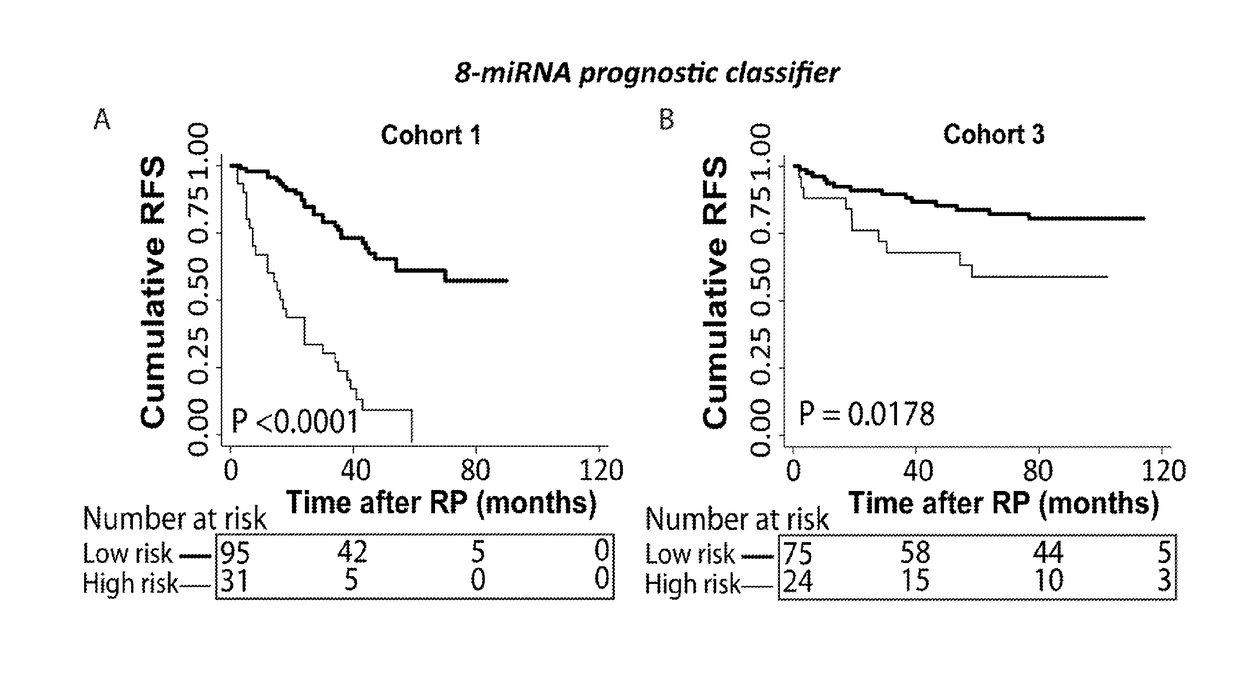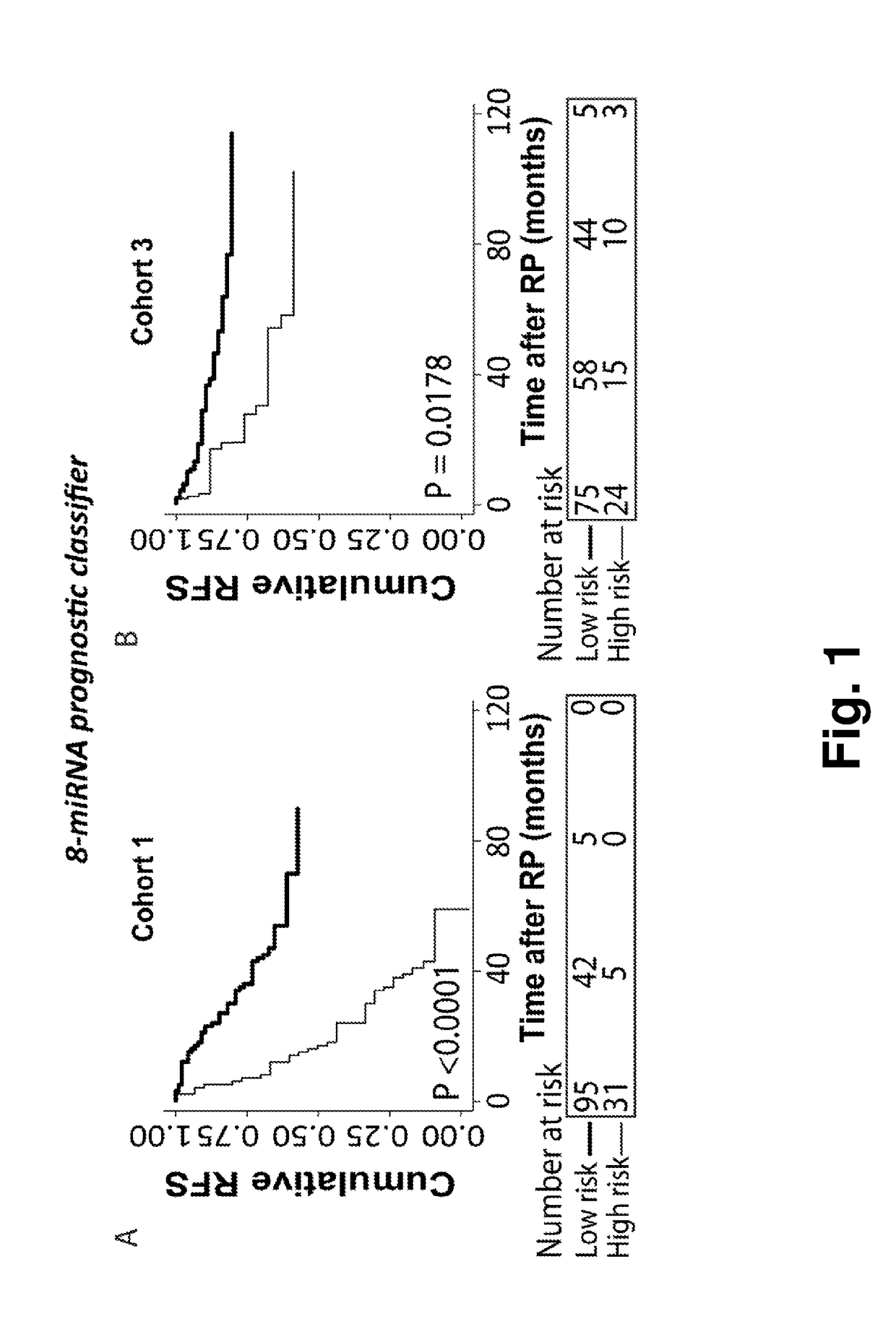A microrna-based method for assessing the prognosis of a prostate cancer patient
a prostate cancer and microrna technology, applied in the field of microrna-based methods for assessing the prognosis of a prostate cancer patient, can solve problems such as the possibility of false negative rates
- Summary
- Abstract
- Description
- Claims
- Application Information
AI Technical Summary
Benefits of technology
Problems solved by technology
Method used
Image
Examples
example 1
[0060]Novel Prognostic Classifiers for Prediction of Prostate Cancer Recurrence Identified by Genome-Wide microRNA Profiling.
Aim of Study
[0061]To investigate prognostic biomarker potential of microRNA expression in prostate cancer and build a classifier for risk stratification.
Methods
Specimens
[0062]All samples were collected at Department of Urology and obtained from Institute of Pathology, Aarhus University Hospital, Denmark (from 1997-2005). The training cohort (cohort 1) consisted of 127 curatively intended RPs of histologically verified clinically localized prostate cancer. All tissue specimens were evaluated by a trained pathologist. Representative regions with >90% tumor were marked on hematoxylin and eosin (H&E) stained sections, and punch biopsies were taken from the corresponding FFPE blocks for RNA extraction as described in (Haldrup 2013). Total RNA was isolated from 1.5 mm punch biopsies using the miRNeasy FFPE Kit (Qiagen), according to the manufacturer's instructions. ...
example 2
[0085]Validation of the 8-microRNA Prognostic Classifier for Prediction of Recurrence Risk in an External Validation Cohort
Aim of Study
[0086]To validate the 8-microRNA classifier, described in Example 1) in an independent RP patient cohort.
Methods
[0087]Specimens and miRNA Expression Data
[0088]We investigated performance of the prognostic potential of the prognostic 8-microRNA classifier in the external GSE21036 microRNA expression dataset from Taylor et al available at the GEO website (14+Hieronymus H, Schultz N, Gopalan A, Carver B S, Chang M T, Xiao Y, et al. Copy number alteration burden predicts prostate cancer relapse. Proc Natl Acad Sci USA. 2014; 111:11139-44.)
[0089]This dataset included 99 snap-frozen RP tissue samples (cohort 3). Expression of 368 microRNAs was measured using Agilent Human microRNA Microarray 2.0 (14+ Hieronymus H, Schultz N, Gopalan A, Carver B S, Chang M T, Xiao Y, et al. Copy number alteration burden predicts prostate cancer relapse. Proc Natl Acad Sci U...
example 3
[0096]Validation of a Prognostic Reduced 8-miRNA Prognostic Classifier for Prediction of Recurrence Risk in Two Independent Validation Cohorts
Aim of Study
[0097]To validate the 3-microRNA classifier (miR-152-3p×miR-185-5p×miR-221-3p); which is the reduced classifier from the 8-microRNA classifier described in Example 1 and 2), in two independent RP patient cohorts: Cohort 2 and cohort 3.
Methods
Specimens
[0098]Two cohorts were used for validation. Cohort2: For miRNA profiling by RT-qPCR, we used formalin-fixed paraffin-embedded (FFPE) prostate tissue samples. All samples were collected at Department of Urology and obtained from Institute of Pathology, Aarhus University Hospital, Denmark (from 1997-2005). For cancer samples, representative regions with >90% tumor were marked on hematoxylin and eosin (H&E) stained sections, and punch biopsies were taken from the corresponding FFPE blocks for RNA extraction as described in (Haldrup 2013). Total RNA was isolated from 1.5 mm punch biopsies ...
PUM
| Property | Measurement | Unit |
|---|---|---|
| absorbance ratio | aaaaa | aaaaa |
| PSA | aaaaa | aaaaa |
| time | aaaaa | aaaaa |
Abstract
Description
Claims
Application Information
 Login to View More
Login to View More - R&D
- Intellectual Property
- Life Sciences
- Materials
- Tech Scout
- Unparalleled Data Quality
- Higher Quality Content
- 60% Fewer Hallucinations
Browse by: Latest US Patents, China's latest patents, Technical Efficacy Thesaurus, Application Domain, Technology Topic, Popular Technical Reports.
© 2025 PatSnap. All rights reserved.Legal|Privacy policy|Modern Slavery Act Transparency Statement|Sitemap|About US| Contact US: help@patsnap.com



